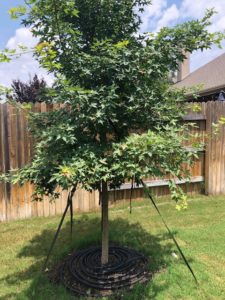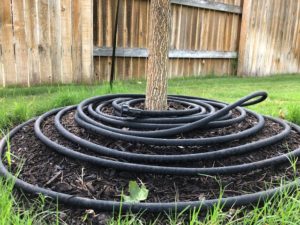First of all, I’d like you to know that this is a difficult subject to write about. There is no “one size fits all” for watering newly planted trees, shrubs and perennials. Soils are different, climatic conditions are variable, and plants are different in their water needs and the rate at which they establish. That being said, I will attempt to give you some “guidelines”. I am sure that you will need to adjust them to your own set of conditions.
Trees
*Newly planted trees will require from 1-5 years of special attention to watering. In most cases, hand watering is best. Each year the watering should be extended OUT from the tree a few feet. Younger trees will establish faster than older, larger trees. The general rule of thumb is one year of establishment for each inch of tree caliper. Of course, this may vary by species and soil type.


*Soaker hoses may be wound around the top of the planting area and run for several hours (depending on flow rate and size of root system) to water a newly planted tree. The water needs to reach the bottom of the original root ball to be effective.

*Note: This tree has been planted “high” due to heavy clay soils. Ideally, the mound would extend out five feet for every foot the tree is raised. Since it is difficult to water a tree planted this way by hand, the soaker hose is likely the best option.
*If bubblers are used to establish a tree, more than one bubbler will ensure more even watering of the root system. If only one side of the root system is watered, the leaves and branches on the side of the tree that did not receive water may die.
*THIS IS IMPORTANT!!! Lawn irrigation and rain do not adequately water a newly planted tree! The canopy sheds rainwater to the edge of the dripline of the tree and little water penetrates the area near the trunk to the depth of the original root system. If it rains, water the planting hole anyway.

*Trees should be planted with a “berm” around the edge of the planting hole. This creates a watering basin or reservoir that can be filled over and over until enough water has been applied to reach the bottom of the original root system. The berm should extend beyond the original root ball to encompass 6”-12” of surrounding soil. This will encourage the roots to grow out from the original root system to the surrounding soil. After the tree is considered established, the berm may be removed, and deep watering should expand to at least the edge of the canopy.
*Mulch and excess soil from the planting hole may be used to create the “berm”. Mulch may be added over the top of the planting hole, but should not be more than 3” deep. Mulch should be pulled back 3”-6” from the trunk to avoid damage to the vascular system of the tree which is just under the thin bark of a young tree. ALWAYS PULL BACK THE MULCH FROM THE TRUNK OF THE TREE!
*When the soil is dry 3”-4” down, depending on the size of the root ball, it is time to water. A moisture meter inserted to a depth of 6″ at a couple of locations in the root ball should give you a good idea of the moisture remaining. If the results come up medium to dry when inserted several inches down, it is time to soak the planting hole.
*Pay attention to weather forecasts that predict higher than normal temperatures or windy conditions that will cause the tree to require increased watering frequency due to increased transpiration.
*Send the tree into the day hydrated. If you wait until late in the day to water, the tree will be experiencing the lowest moisture content in the soil at the hottest part of the day.
*Trees planted in the fall will not require as frequent watering as trees planted in the spring and summer. Spring-planted trees will usually require daily watering throughout the first summer after the tree is planted.
*After the tree is established, it generally takes about 2” of rain or irrigation water to adequately water an established tree under the canopy. This will vary with different soil types.
*Fact: Tree roots can grow 2-3 times the height of the tree OUT from the tree. This area under the canopy and beyond is where established trees should be watered, NOT just at the trunk!
*Fact: The majority of tree roots that absorb water and nutrients are in the top 1’-2’ of the soil. Roots require oxygen, and that is where they will find it.
Shrubs
*Newly planted shrubs require hand watering until the root system has grown out into the surrounding soil in the bed.
*Rain or overhead sprinkler irrigation alone is not adequate to establish newly planted shrubs. The canopy of leaves will shed the water to the outside of the planting hole and the original root system will dry out.
However:
*Irrigation should be run in the planting beds in addition to hand watering, as this will encourage the roots to grow out into the surrounding soil. Frequency of irrigation will depend on the time of the year and the temperature.
*Different species of plants root out at different rates, and the time of the year it is planted will also determine how fast the shrub will establish.
*If you plant in the spring, you should plan on hand watering into the summer or even until fall, especially if you are under water restrictions for sprinkler irrigation.
*Winter-hardy shrubs will benefit from being planted in the fall, as the roots will grow all winter. Watering frequency will be reduced and the plant will put on a flush of growth in the spring.
*Any marginally winter-hardy shrubs should be well-established going into the winter, and should be planted in the spring if possible.
Perennials
*Perennials generally root out faster than trees and shrubs, but still require hand watering until the roots grow out into the soil that will be irrigated.
*Just because a perennial is advertised as “drought resistant” does NOT meant that it is drought resistant in a pot or right after planting. This term refers to an established plant.
*Since the root system on the perennial plant is likely coming out of a one- or two-gallon container, it may be possible to use a sprinkler to establish these plants if desired. Use a sprinkler with large droplets of water, not one with small droplets, as the water will have to get through the foliage to the original root ball. Allowing the water to rise up about 3′-4′ will keep the water droplets larger. The root balls are not as deep as the larger shrub and tree root balls, so watering should be adjusted to reach that depth.
This sprinkler may be used at a low flow rate for the droplet size to be large enough to make a difference.
*After 4-6 weeks, depending on the time of year and the species of plant, your perennial should be established enough to turn it over to irrigation. Some species in certain soils may require more than once a week irrigation.